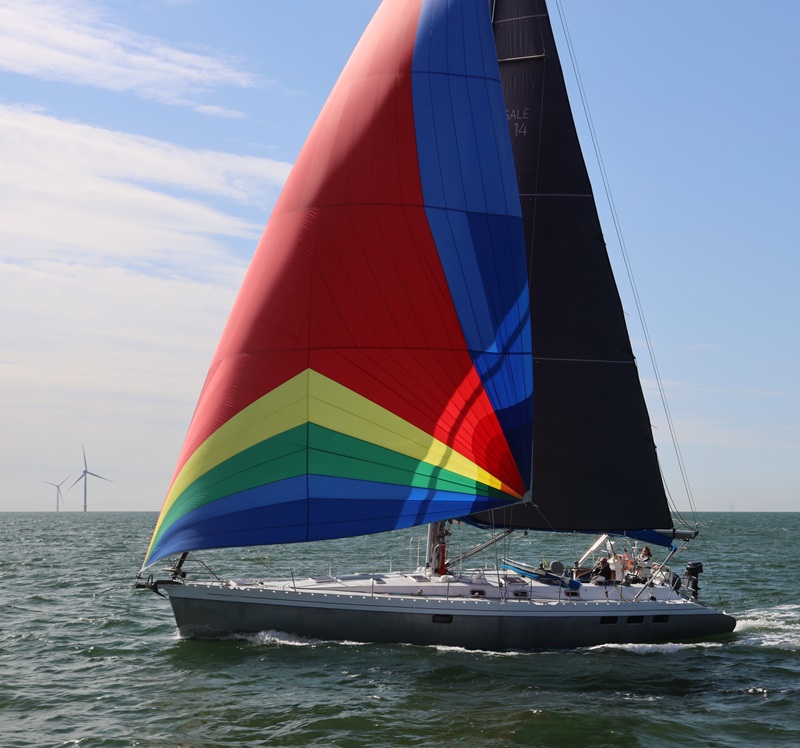Review of Cigale 14

Basic specs.

Looking for a new boat? Find a Cigale 14 or similar boat for sale
The hull is made of aluminium. Aluminum is strong and forgiving. Where an impact on a fiberglass hull will result in major gelcoat damage and possible cracking, an aluminum hull will probably only have a scratch or a small bend. The only concern is electrolysis. Ensure that you have proper sacrificial anodes installed.
The boat is equipped with 6-8 berths and 500.0 liter fresh water capacity.
The Cigale 14 is equipped with a masthead rig. The advantage of a masthead rig is its simplicity and the fact that a given sail area - compared with a fractional rig - can be carried lower and thus with less heeling moment.
Fin keel
The Cigale 14 is equipped with a fin keel. A boat with a fin keel is more manoeuvrable but has less directional stability than a similar boat with a full keel.
The boat can only enter major marinas as the draft is about 2.20 - 2.30 meter (7.22 - 7.52 ft) dependent on the load. See immersion rate below.
Sailing characteristics
This section covers widely used rules of thumb to describe the sailing characteristics. Please note that even though the calculations are correct, the interpretation of the results might not be valid for extreme boats.
What is Capsize Screening Formula (CSF)?
The capsize screening value for Cigale 14 is 2.06, indicating that this boat would not be accepted to participate in ocean races.
Cigale 14 holds a CE certification:
The boat is by European Union certified as Class A. OCEAN:What is Theoretical Maximum Hull Speed?
The theoretical maximal speed of a displacement boat of this length is 8.9 knots. The term "Theoretical Maximum Hull Speed" is widely used even though a boat can sail faster. The term shall be interpreted as above the theoretical speed a great additional power is necessary for a small gain in speed.
The immersion rate is defined as the weight required to sink the boat a certain level.
The immersion rate for Cigale 14 is about 397 kg/cm, alternatively 2228 lbs/inch.
Meaning: if you load 397 kg cargo on the boat then it will sink 1 cm.
Alternatively, if you load 2228 lbs cargo on the boat it will sink 1 inch.
Sailing statistics
This section is statistical comparison with similar boats of the same category. The basis of the following statistical computations is our unique database with more than 26,000 different boat types and 350,000 data points.
What is Motion Comfort Ratio (MCR)?
The Motion Comfort Ratio for Cigale 14 is 21.3.
What is L/B (Length Beam Ratio)?
The l/b ratio for Cigale 14 is 3.33.
The ballast ratio for Cigale 14 is 33%.
What is Displacement Length Ratio?
The DL-ratio for Cigale 14 is 113 which categorizes this boat among 'ultra light racers'.
SA/D (Sail Area Displacement ratio)
Indicates how fast the boat is in light wind:
- Cruising Boats have ratios 10-15
- Cruiser-Racers have ratios 16-20
- Racers have ratios above 20
- High-Performance Racers have ratios above 24
Sail-area/displacement ratio (SA/D ratio): 23.20
Maintenance
When buying anti-fouling bottom paint, it's nice to know how much to buy.
The surface of the wet bottom is about 67m2 (721 ft2).
Based on this, your favourite maritime shop can tell you the quantity you need.
Note: If you use a paint roller you will need more paint than if you use a paintbrush.
If you need to renew parts of your running rig and is not quite sure of the dimensions, you may find the estimates computed below useful.
| Usage | Length | Diameter | ||
| Jib sheet | 14.7 m | (48.1 feet) | 16 mm | (5/8 inch) |
| Genoa sheet | 14.7 m | (48.1 feet) | 16 mm | (5/8 inch) |
| Mainsheet | 36.7 m | (120.3 feet) | 16 mm | (5/8 inch) |
| Spinnaker sheet | 32.3 m | (105.9 feet) | 16 mm | (5/8 inch) |
This section is reserved boat owner's modifications, improvements, etc. Here you might find (or contribute with) inspiration for your boat.
Do you have changes/improvements you would like to share? Upload a photo and describe what you have done.
We are always looking for new photos. If you can contribute with photos for Cigale 14 it would be a great help.
If you have any comments to the review, improvement suggestions, or the like, feel free to contact us. Criticism helps us to improve.
